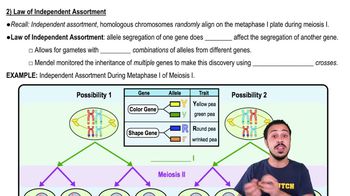Mendel's Laws quiz #1 Flashcards
Terms in this set (16)
What does Gregor Mendel's Law of Segregation state about allele separation during meiosis?
The Law of Segregation states that during meiosis, two alleles of the same gene separate from each other and end up in different gametes, making the gametes haploid.
How does the Law of Segregation ensure that gametes are haploid?
The Law of Segregation ensures that gametes are haploid by making sure each gamete receives only one copy of a gene or allele.
What is the genetic composition of a homozygous dominant cell before meiosis?
A homozygous dominant cell has two dominant alleles before meiosis.
What happens to the alleles during DNA replication before meiosis?
During DNA replication before meiosis, each allele is duplicated, resulting in an extra copy of each allele.
What is the outcome of meiosis in terms of allele distribution in gametes?
After meiosis, each of the four alleles segregates independently, resulting in gametes that each contain only one copy of the allele.
What does the Law of Independent Assortment state about the segregation of alleles for different genes?
The Law of Independent Assortment states that the segregation of alleles for one gene does not affect the segregation of alleles for another gene.
During which phase of meiosis does independent assortment occur?
Independent assortment occurs during metaphase I of meiosis I.
How does independent assortment contribute to genetic diversity?
Independent assortment contributes to genetic diversity by allowing homologous chromosomes to align randomly, creating various combinations of alleles in gametes.
What is a dihybrid cross and how did it help Mendel discover the Law of Independent Assortment?
A dihybrid cross is a cross between organisms that are heterozygous for two different genes, and it helped Mendel discover the Law of Independent Assortment by showing that allele segregation for one gene is independent of another.
What are the possible allele combinations for the color and shape genes in pea plants due to independent assortment?
The possible allele combinations are yellow round, yellow wrinkled, green round, and green wrinkled peas.
What is a monohybrid cross?
A monohybrid cross is a cross fertilization event between two organisms that are heterozygous for one specific gene.
What does a Punnett Square for a monohybrid cross show?
A Punnett Square for a monohybrid cross shows the possible genetic combinations of offspring from two heterozygous parents for one gene.
What are the possible genotypes in the offspring of a monohybrid cross?
The possible genotypes are homozygous dominant, heterozygous, and homozygous recessive.
How does the Law of Segregation apply to a monohybrid cross?
The Law of Segregation applies to a monohybrid cross by ensuring that each gamete receives only one allele from each parent, resulting in the observed genotypic ratios.
What is the significance of Mendel's Laws in genetics?
Mendel's Laws, including the Law of Segregation and the Law of Independent Assortment, are fundamental principles that explain how traits are inherited through the segregation and independent assortment of alleles.



